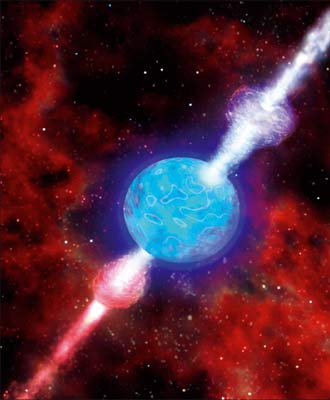
Image credit: Dana Berry, SkyWorks Digital/NASA.
X-ray observations of gamma-ray bursts (GRBs) by the Swift satellite suggest that the central engine can be active for up to a few hours. A new theoretical study shows that this is difficult to explain in the standard scenario of jet formation and instead proposes a different mechanism that would work not only for collapsing stars but also for stars invaded by a black hole companion in a binary system.
The collection of hundreds of GRB afterglows by NASA’s Swift satellite since its launch in November 2004 is an observational breakthrough in the characterization of these powerful stellar explosions. The typical X-ray-afterglow emission is characterized by a rapid fading in the first minutes followed by a shallow decay lasting up to a few hours and a somewhat steeper decay afterwards. In addition, many GRB afterglows show X-ray flares superimposed on this general trend (CERN Courier October 2005 p11). While those features are consistent with the cannonball model, they were unexpected in the frame of the standard fireball model (CERN Courier December 2005 p20). Despite these difficulties, the latter remains the favoured model for long GRBs.
In this context, the intermediate shallow decay and the presence of X-ray flares are interpreted as evidence of ongoing activity of the central engine for several hours after the prompt GRB. This is a problem for models in which the ultra-relativistic jet at the origin of the GRB phenomenon is powered by the annihilation of neutrinos in a disc of matter that forms around a nascent black hole at the heart of a collapsing star. Indeed, the neutrino-heating mechanism requires a high mass-accretion rate onto a rapidly spinning black hole – a process that cannot be sustained for more than a few minutes.
A new theoretical study by Maxim V Barkov and Serguei S Komissarov from the Department of Applied Mathematics at the University of Leeds proposes an alternative to the prolonged neutrino-heating problem in the standard “collapsar” model. They demonstrate that jets of long GRBs can also be powered via a magnetic process, such as the Blandford–Znajek mechanism. This mechanism, proposed in 1977, uses the rotational energy of the spinning black hole to power the jet. Compared with the neutrino-driven GRB model it has the advantage that it can account for the prolonged jet activity with a somewhat lower constraint on the spin of the black hole; but on the other hand, it requires a strong magnetic field at the black-hole horizon. One way to reduce the magnetic constraint is to start with a neutrino-driven supernova explosion that opens jet channels for the subsequent magnetically driven GRB.
A particularly interesting possibility discussed by Barkov and Komissarov is the case of a close binary system composed of a Wolf-Rayet star – a massive, dense star that has blown away its outer layer of hydrogen – and a black hole. The black hole could lose momentum in the wind of the companion star and ultimately spiral into the star’s centre, devouring it from the inside. In the Milky Way, there is luckily only one such binary system, Cyg X-3, which has an orbital period of about 5 hours. The black hole might eventually parasite on the Wolf-Rayet star, disrupt it and produce a GRB to be observed in billions of years’ time in a remote galaxy.
Further reading
M V Barkov and S S Komissarov 2009. Submitted to MNRAS.
http://arxiv.org/abs/0908.0695.








